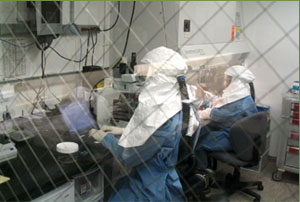Notes from Microbiology
On this page, Mary DeMartino, BS, MT (ASCP) SM, and other technical experts at the Hygienic Laboratory will share information about protocols, best practices and news of interest to microbiology technologists.
Questions for Mary to address on this page can be sent via the contact page.
VISA/VRSA:
Staphylococcus aureus isolates that exhibit decreased susceptibility to vancomycin are of clinical and public health importance. A link to the updated CDC algorithm for testing these organisms is included here (where it says to send isolates to CDC, please substitute SHL). VISA and VRSA are part of the Iowa Department of Public Health Table of Reportable Communicable and Infectious Diseases. Suspect VISA/VRSA isolates are to be sent to SHL for confirmation. Please follow the updated protocol listed here to for proper submission of these isolates to SHL.
Protocol for Clinical Laboratories with a Possible Vancomycin Intermediate or Resistant Staph aureus (VISA/VRSA) - (PDF) - Updated 4/15/2013
One of the most common reasons submitted isolates do not confirm as VISA or VRSA is that the isolate is not a Staph aureus or is not a pure isolate. To prevent an erroneous report of VISA/VRSA, please refer to the list below to verify the purity and identification of the isolate prior to submission to SHL for confirmation.
- Verify the purity of the isolate tested by closely inspecting the purity plate inoculated during your automated-panel setup.
- Verify the identification of the isolate in the panel by performing a Gram stain, catalase and coagulase from the purity plate inoculated during your automated panel setup.
- If you are using Vancomycin screening agar:
- Verify that you are following the package insert instructions for inoculation, to prevent a heavy inoculum from exhibiting growth and being misinterpreted as resistance.
- Verify the purity and identification of the organism growing on this plate by performing Gram stain, catalase and coagulase from this plate if allowed by the manufacturer.
- Remember that the concentration of vancomycin in these plates is at 6ug/uL and will not detect those Staph aureus isolates with an MIC of 4 ug/uL.
- If you can verify the purity of the isolate and identification of the organism as Staph
aureus:
- Call SHL Bacteriology (319-335-4335) to notify us of your intent to submit this organism for confirmation of decreased susceptibility to vancomycin. During this call we will verify certain information and provide instructions for shipment. We also need you to make this call prior to shipping so we can subculture appropriate QC organisms and be ready to begin testing on the day the organism arrives.
- Notify your Infection Prevention department and the physician of a POTENTIAL VISA/VRSA. Tell them you are sending the isolate to SHL for confirmation.
- Call IDPH to inform them of a POTENTIAL VISA/VRSA. Tell them you are sending the isolate to SHL for confirmation.
- Use the Bacteriology Test Request Form. Please print the form from your secure web access portal or from the website to ensure you are using the latest version of this document. Fill out the form completely. Under the Test Requested section, select "Other" and write in "Confirmation of VISA/VRSA." Attach a copy of your susceptibility results and any additional information available to you.
- CDC wants only isolates that display unusual susceptibility patterns, and we will forward the isolate to them if necessary. If this happens you will see a "pending" reference lab test on your report. We will forward the CDC results to you when we receive them.
Another reason that an isolate may not confirm as VISA/VRSA at SHL is serial subculturing of the isolate. Upon subsequent subculturing, a VISA/VRSA isolate may lose the gene for decreased susceptibility to vancomycin. To avoid this situation:
- Please submit the
purity plate from your susceptibility panel, the vancomycin screening agar plate, and/or
the original plate on which the Staph aureus was identified. Any or all of these will
work; the less the organism was subcultured the better.



